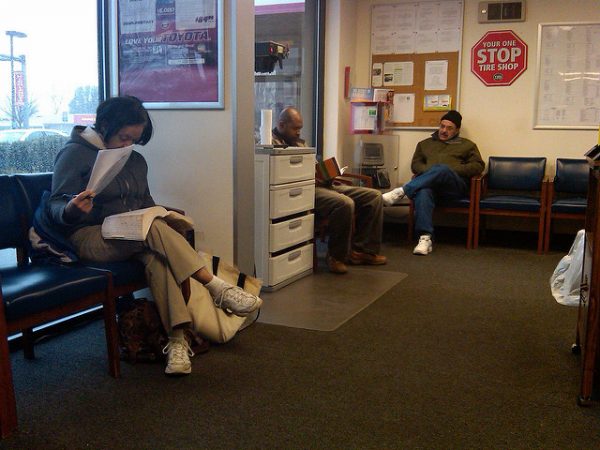
What happens in a hospital waiting room? From one perspective, not a lot. But from another perspective, medical waiting rooms are emotionally-fraught spaces where individuals constantly identify and play out social scripts. Individuals follow sign-in procedures, wait on doctors, choose how to interact with strangers, and care for family members. Margaret Waltz spent four months observing one aspect of these mini social dramas: gender. Her study examines whose time is valued, as well as how the social interactions within medical waiting rooms reinforce gendered expectations and hierarchies.
To conduct this research, Waltz observed in five hospital waiting rooms. She recorded when patients entered and left and took notes on their behavior within the room. The result includes both basic demographic information — such as the fact that all the home health care workers were women, while all of the drivers and other transport personnel from nursing homes were men — and patterns of interaction. Her writing is sprinkled with anecdotes of privilege, such as when a White man, holding coffee and a donut, asked a nurse to open the door for him — prompting laughter from the women in the waiting room.
On a basic level, the logic of medical waiting rooms is (mostly female) caregivers waiting on (mostly male) professionals. According to Waltz, “women are doing gender by waiting in medical waiting rooms, and men are doing gender by not waiting.” In addition to more women working as home health care workers, women were also more likely to accompany a family member to the hospital, making them a more constant presence in medical waiting rooms regardless of whether men were the majority of the patients. Waiting was, therefore, part of their work, whether that work was paid or unpaid. And once in the waiting room, women were more likely to use the waiting room as a social space to bond with other individuals.
Men, by contrast, were more likely to be in positions where they did not need to wait (such as serving as drivers), to arrive late to an appointment or leave before their family member was seen, and to expect to be served immediately. Men were also more likely to take up what Waltz called “physical and auditory space,” spreading out over multiple chairs, talking loudly on the phone, or assuming that nurses had the time to speak with them. Waltz’s research reveals that even the structured and bureaucratic spaces of American health care are places where gender is recreated. Men and women in these spaces interact in ways that conform to gendered expectations and reinforce the conception that men’s time (and work) is more valuable than women’s.

Comments 1
Mary Billups — April 10, 2018
Great work! Spending lots of time at the hospital these days and can validate your observations.